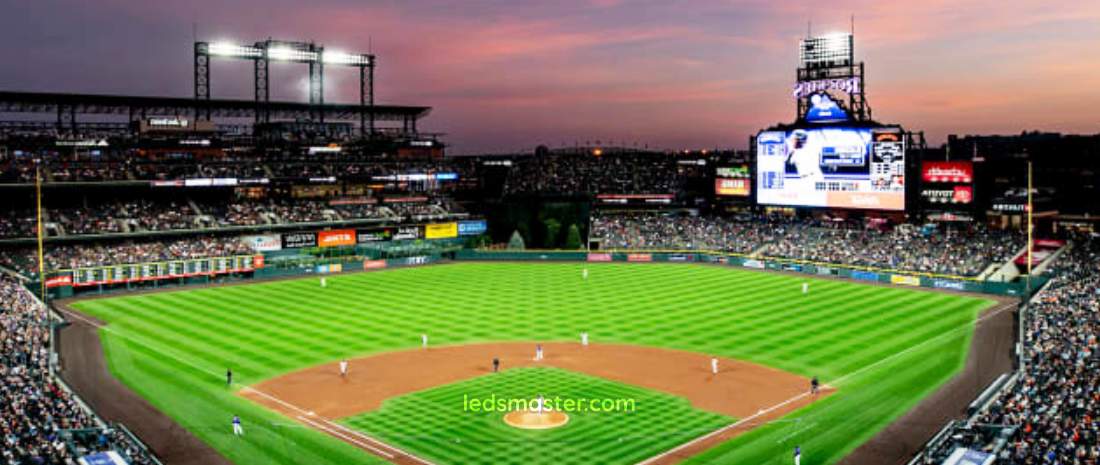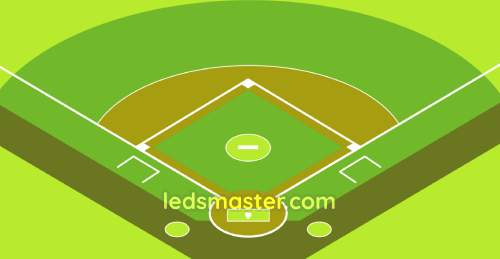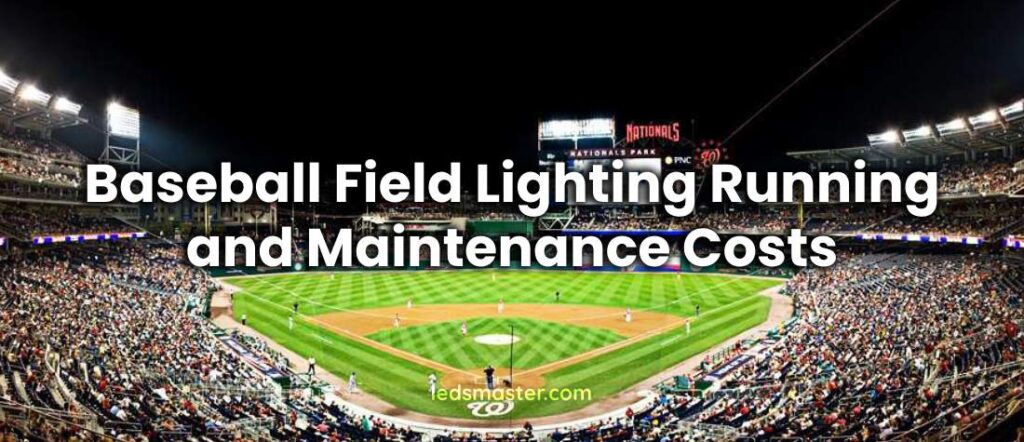Replacing metal halide spotlights in a League baseball stadium involves several considerations, including the cost of the new lighting system, installation expenses, running costs, and the advantages of switching to LED lights. This guide will cover these aspects to help you make an informed decision about upgrading your baseball field lighting.
Table of Contents
ToggleCost of Baseball Field Lighting
Initial Costs
Installing baseball field lights involves significant upfront investment. For LED systems, the cost typically ranges from $40,000 to $70,000, which covers the lights themselves and the necessary equipment for installation. LED lights generally require about 30,000 to 60,000 watts to adequately illuminate a baseball field. This expenditure, although substantial, represents only a small fraction (1 to 3%) of the total construction cost of a baseball stadium.
The exact cost is influenced by several factors, primarily the size and purpose of the field. For instance, a stadium designed for Major League Baseball (MLB) or Olympic-standard games necessitates more extensive and higher-quality lighting systems. These venues demand higher brightness levels, better uniformity, and advanced features like anti-glare and flicker-free technology to ensure optimal performance for players and viewers alike. Consequently, the costs for such high-end installations can be significantly higher.
The brand and technology of the LED lights also affect the initial costs. High-quality LED lights from reputable manufacturers, which offer better durability and performance, may come at a premium. However, these lights often provide better value over time due to lower maintenance and running costs.

Running Costs
The running costs of baseball stadium lights vary based on the type of lighting system used. In the United States, where the average electricity cost ranges from $0.10 to $0.14 per kilowatt-hour (kWh), a stadium using 50,000 watts of LED lights incurs a running cost of approximately $5 per hour. Assuming the lights are used for six hours per day, the daily cost would be around $30, and the monthly cost (based on 20 days of use per month) would be approximately $600.
In contrast, traditional metal halide lamps, which are less energy-efficient, would incur double the electricity cost to produce the same brightness. This means that for the same level of illumination, the running cost for metal halide lamps would be around $1,200 per month. This significant difference in running costs highlights the energy-saving benefits of LED lighting systems.
LED lights are more efficient because they convert a higher percentage of electricity into visible light, with less energy wasted as heat. This efficiency translates into lower electricity bills, making LED lights a cost-effective option in the long run, despite their higher initial costs.
Installation Costs
The installation costs for baseball field lights can vary widely, typically ranging from 30% to 80% of the total cost of the lights. For large-scale and complex projects, the installation cost can be between $10,000 and $25,000. These costs cover the labor, equipment, and other resources needed to properly install the lighting system.
Several factors influence installation costs, including the complexity of the project, the height and number of light poles, and the layout of the field. High poles, for instance, require more robust foundations and specialized equipment to install, increasing the costs. Additionally, the type of lighting system being replaced can affect installation costs. Upgrading from older systems like metal halide or HPS to modern LED systems may require additional adjustments or modifications to the existing infrastructure.
Selecting durable luminaires is essential to minimize long-term expenses. High-quality LED lights with robust construction and advanced features can withstand harsh weather conditions and provide reliable performance over many years, reducing the need for frequent replacements or repairs.

Maintenance Costs
LED lights offer significantly lower maintenance costs compared to traditional lighting systems. With a lifespan of around 80,000 hours, LED lights can last at least 20 years, even under adverse weather conditions. This longevity is due to the advanced technology and materials used in LED lights, which ensure they operate efficiently and reliably for extended periods.
LED lights also come with an IP66 rating, indicating high resistance to dust and water ingress. This makes them suitable for outdoor installations where they are exposed to the elements. The advanced heat dissipation systems in LED lights help maintain optimal performance by reducing the junction temperature of the light-emitting diodes (LEDs), thereby extending their lifespan.
The maintenance cost for LED lights is nearly zero because of their durability and long lifespan. Traditional lighting systems like metal halide, HPS, and LPS lamps require regular maintenance and replacements due to their shorter lifespans and susceptibility to damage. These maintenance activities can be costly and time-consuming, involving labor, replacement parts, and potential downtime for the lighting system.
Advantages of LED Replacement for Baseball Field Lighting
High Energy Efficiency
One of the most compelling advantages of LED lighting is its superior energy efficiency compared to traditional High-Intensity Discharge (HID) lights such as metal halide, High-Pressure Sodium (HPS), and Low-Pressure Sodium (LPS) lamps. LED lights exhibit approximately 80% higher luminous efficacy. This means that they convert a greater proportion of electrical energy into visible light, with less energy wasted as heat. For example, a baseball stadium that previously required 100,000 watts of HPS lighting would now only need between 30,000 and 40,000 watts of LED lighting to achieve the same level of illumination. This substantial reduction in energy consumption translates directly into lower electricity bills and a smaller carbon footprint, making LED lights an environmentally and economically sound choice.
Better Lighting Uniformity
LED floodlights are engineered with asymmetric lens designs to provide superior lighting uniformity. This feature is particularly crucial for sports like baseball, where the consistent and bright illumination of the entire field is essential due to the fast-moving nature of the game. Traditional lighting systems often create observable dim or bright spots on the field, which can impair players’ vision and affect their performance. In contrast, the advanced optics of LED lights distribute light more evenly across the playing surface, enhancing visibility for players, officials, and spectators. This improved uniformity not only contributes to a better playing experience but also enhances the overall aesthetic appeal of the stadium during evening events.
Anti-Glare and Flicker-Free Performance
Glare and flicker are two significant issues associated with traditional stadium lighting that can be effectively mitigated with LED technology. Glare, which refers to the blinding effect when looking directly at bright lights, can be distracting and even hazardous for players and spectators. LED lights incorporate special coatings and precise lens arrangements to reduce glare by about 30%, creating a more comfortable and safer viewing experience. Additionally, LED lights are designed to be flicker-free, making them compatible with high-speed photography and video recording. This feature is particularly important for modern sports broadcasting, especially for 4K ultra-high-definition television, where even minor flickering can be noticeable. LED lights maintain a consistent brightness level with a flicker rate of about 0.2% at maximum lumens, ensuring high-quality video production.
Versatility
LED lighting solutions are incredibly versatile, making them suitable for a wide range of baseball fields, from small recreational parks to professional stadiums. They can be tailored to meet the specific lighting requirements of different venues, whether it’s a high school field, a college stadium, a public park, or a major league field. LED systems are available in various configurations and power levels, allowing for customization based on the field’s size, usage patterns, and the level of competition. This versatility ensures that each venue can achieve optimal lighting conditions, enhancing the experience for players and spectators alike.
Importance of Lighting in Baseball Stadiums
Enhanced Viewing Experience
Proper lighting is a critical component of the overall experience at a baseball stadium, impacting both players and spectators. For players, adequate lighting ensures that they can see the ball clearly and react quickly, which is essential for high-level performance. For spectators, whether they are watching the game live or through a broadcast, high-quality lighting enhances their viewing experience by providing clear and vibrant visuals. Poor lighting can lead to missed plays and reduce the enjoyment of the game. By upgrading to LED lighting, stadiums can ensure that games are enjoyable for everyone, regardless of their vantage point.
Compliance with International Standards
For venues hosting international tournaments, compliance with specific lighting standards is essential. Major events like the World Baseball Classic, Little League Tournament, and the Summer Olympics require lighting that meets stringent specifications to ensure uniformity, brightness, and overall quality. LED lights are often designed to be compatible with these international standards, providing a reliable solution for stadiums aiming to host such prestigious events. By investing in LED lighting systems, venues can ensure that they meet or exceed these standards, making them suitable for hosting high-profile competitions.
Safety and Environmental Impact
Safety is another critical factor enhanced by LED lighting. The superior illumination provided by LEDs reduces the likelihood of accidents and injuries, both on the field and in the stands. Additionally, the longer lifespan and lower maintenance requirements of LED lights mean fewer replacements and less waste, contributing to a more sustainable and environmentally friendly operation. LED lights also do not contain harmful substances like mercury, which is found in some traditional lighting options, further reducing their environmental impact.
Understanding Baseball Field Dimensions
Field Size and Structure
 A baseball field’s layout is crucial to designing an effective lighting system. The field is divided into two main sections: the infield and the outfield. The infield is the diamond-shaped area where most of the action occurs, including pitching, batting, and base running. The outfield extends beyond the infield and is where fielders catch fly balls and chase down grounders.
A baseball field’s layout is crucial to designing an effective lighting system. The field is divided into two main sections: the infield and the outfield. The infield is the diamond-shaped area where most of the action occurs, including pitching, batting, and base running. The outfield extends beyond the infield and is where fielders catch fly balls and chase down grounders.
The dimensions of a baseball field can vary significantly based on its level of play and intended use. The length of the foul lines, which stretch from home plate to the outfield fence, typically ranges from approximately 90 to 130 meters (295 to 425 feet). These measurements are crucial because they directly influence the amount of lighting power needed to ensure proper visibility across the entire field.
For instance, a Major League Baseball (MLB) stadium will have more extensive dimensions and require more powerful lighting systems compared to a high school or recreational field. Understanding these dimensions helps in calculating the precise amount of lighting needed to achieve optimal illumination, ensuring that both players and spectators have a clear view of the game.
Height of Light Poles
The height of the light poles in a baseball stadium is another critical factor in achieving effective field lighting. These poles can range from 15 meters (49 feet) to 50 meters (164 feet) in height, depending on the level of play and specific requirements of the venue. Higher poles are typically used in professional fields to ensure uniform lighting and reduce glare, enhancing the overall visibility for players and spectators.
In professional stadiums, higher poles allow for better distribution of light across the entire field, minimizing shadows and dark spots. This is particularly important in baseball, where players need to track fast-moving balls both in the infield and the outfield. High poles also help in reducing glare by directing the light downward and away from the players’ line of sight.
For instance, a league or Olympic-standard stadium might require light poles that are 50 meters high and equipped with powerful LED lights ranging from 10,000 to 50,000 watts. This setup ensures that the field is brightly and evenly lit, meeting the stringent standards required for professional and international competitions.
In contrast, recreational parks and smaller venues may not need such high poles or powerful lighting systems. These fields often use poles around 15 to 30 meters (49 to 98 feet) in height, with lighting systems that are appropriately scaled to the size of the field. This ensures adequate illumination while keeping installation and operational costs manageable.
Conclusion
Upgrading to LED lighting for baseball fields offers numerous benefits, including cost savings, better performance, and compliance with international standards. With a longer lifespan, lower maintenance needs, and higher energy efficiency, LED lights are an excellent investment for any baseball stadium looking to improve its lighting system.

